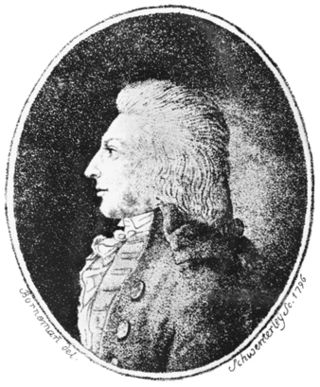
Christiaan Hendrik Persoon was a South African mycologist who made additions to Linnaeus' mushroom taxonomy.
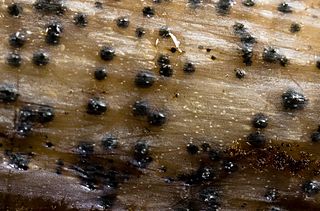
Pleospora herbarum is a species of fungus in the family Pleosporaceae. It is a plant pathogen infecting several hosts including alfalfa, apples, asparagus, tomatoes, citruses and chickpea. It has a cosmopolitan distribution, and is common in temperate and subtropical regions. The fungus was first described under the name Sphaeria herbarum by Christian Hendrik Persoon in 1801.

Peniophora albobadia is a species of crust fungus in the family Peniophoraceae. It is a saprobic fungus, forming spreading crusts on the bark of decaying twigs and fallen branches of many hardwood species. The species epithet is derived from albo-, white, and badi- meaning reddish-brown, the epithet accurately describing the vivid contrast between the fertile area and the margin.

Cymatoderma is a widely distributed genus of poroid fungi in the family Meruliaceae.
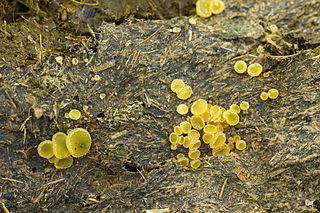
Ascobolus is a genus of fungi in the Ascobolaceae family. The genus has a widespread distribution, and contains an estimated 61 species, most of which are coprophilous. The genus was circumscribed by Christian Hendrik Persoon in 1796.

Thelephora palmata is a species of clavarioid fungus in the family Thelephoraceae. The fruit bodies are leathery and coral-like, with branches that are narrow at the base before widening out like a fan and splitting into numerous flattened prongs. The wedge-like tips are whitish when young, but darken as the fungus matures. The common names of the fungus refers to its pungent odor, likened to fetid garlic. A widely distributed but uncommon species, it is found in Asia, Australia, Europe, North America, and South America, where it fruits on the ground in both coniferous and mixed forest.

Amylostereum is the single genus in the fungal family Amylostereaceae. The genus currently comprises four saprotrophic and parasitic species, which live off living or dead wood. The Amylostereaceae cause white rot in the wood by disintegrating the tissue component lignin. They produce crust-like, partially wavy fruit bodies on the surface of infested trees, which are similar to those produced by Stereum species.
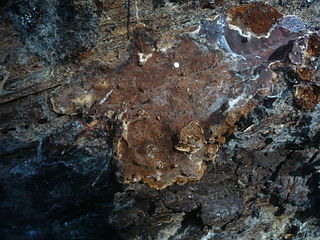
Amylostereum areolatum is a species of crust fungus. Originally called Thelephora areolata in 1828, it was given its current name by French mycologist Jacques Boidin in 1958.
Amylostereum ferreum is a species of crust fungus in the family Amylostereaceae.

Amylostereum laevigatum is a species of crust fungus in the family Amylostereaceae. Originally named Thelephora laevigata by Elias Fries in 1828, it was given its current name when transferred to the genus Amylostereum by French mycologist Jacques Boidin in 1958.

Xylobolus frustulatus, commonly known as the ceramic fungus or ceramic parchment, is an inedible species of crust fungus in the Stereaceae family. The fruit body forms small, hard, flat crust-like aggregations that resemble broken pieces of ceramic tile. These pieces are initially whitish before turning yellow-brown to gray-brown in age. The spore-bearing cells cover the upper surfaces of the fruit body. A saprobic species, it grows on well-decayed oak wood in Asia, northern Europe, and North America.
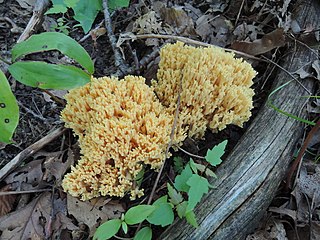
Ramaria decurrens, commonly known as the ochre coral, is a coral mushroom in the family Gomphaceae. It is found in Europe and North America.
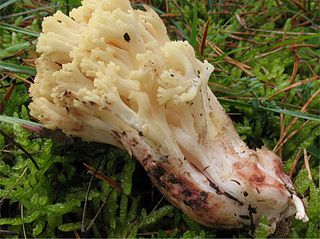
Ramaria sanguinea, commonly known as the bleeding coral or the bloody coral, is a coral mushroom in the family Gomphaceae.

Scutiger pes-caprae is a species of fungus in the family Albatrellaceae. It was first described officially as a species of Polyporus by Christian Hendrik Persoon in 1818. In recent decades, it was known most commonly as a species of Albatrellus until molecular research published by Canadian mycologist Serge Audet in 2010 revealed that it was more appropriate in an emended version of the genus Scutiger.
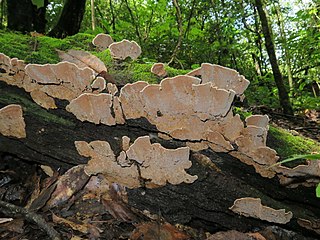
Xylobolus subpileatus is a widely distributed species of crust fungus in the family Stereaceae. It was first described scientifically in 1849 by Miles Joseph Berkeley and Moses Ashley Curtis, who considered the fungus a species of Stereum closely related to but distinct from Stereum rugosum. The original collections were made from specimens growing on dead trunks in the United States of Ohio and South Carolina. Xylobolus subpileatus was given its current name by French mycologist Jacques Boidin when he transferred it to the genus Xylobolus in 1958.

Gliophorus laetus is a species of agaric fungus in the family Hygrophoraceae. Originally described as new to science by Christian Hendrik Persoon in 1800, it was transferred to the genus Gliophorus in 1958. It is considered edible, but of little interest.
Leccinum leucophaeum is a species of bolete fungus in the family Boletaceae. It was originally described as new to science in 1825 by Christian Hendrik Persoon, and transferred to Leccinum by French mycologist Marcel Bon in 1981.

Lycoperdon lividum, commonly known as the grassland puffball, is a type of puffball mushroom in the genus Lycoperdon. It is found in Europe, where it grows on sandy soil in pastures, dunes, and heaths, especially in coastal areas. It fruits in autumn. It was first described scientifically in 1809 by Christian Hendrik Persoon.
Sarcodon bubalinus is a European species of tooth fungus in the family Bankeraceae. First described by Christian Hendrik Persoon in 1825 as Hydnum bubalinum, it was transferred to the genus Sarcodon by Rudolph Arnold Maas Geesteranus in 1956.

Amphinema byssoides is a species of corticioid fungus known to form mycorrhizal relationships with spruce trees.

















